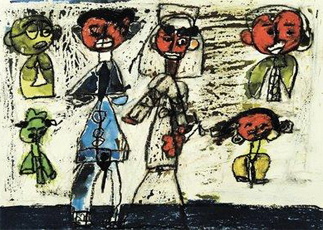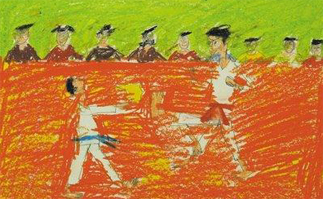Breaking down barriers for autistic children

Two of the 12 winners of the EKF’s drawing event for autistic children. “A Beautiful Wedding” by Lee Hye-rim, Cheongju Seongsin School, North Chungcheong.
Still, she feels that there is a social stigma separating her nephew and other “ordinary” kids.
Aladin found that this social prejudice against autistic people is just as prevalent in Korea. In some cases, she said, it’s actually worse, as parents of an autistic child here try to keep it secret from the wider world.
“Autistic children here, I believe, are forgotten for some reason,” Aladin said in a telephone interview from her office in Seoul Monday.

“Taekwondo” by Cho Jun-hyeoung, Miral School, Seoul. Provided by the Europe Korea Foundation
The EKF recently organized a drawing event for autistic children, the first of its kind in Korea. As communications director of the ETF, Aladin assumed a pivotal role in the event.
With some effort, she succeeded in contacting the Autism Society of Korea, an organization devoted to helping autistic children, which gave her an update on the situation here.
She found that there was very little public awareness of autism, even among families with autistic children.
The organization estimates there are more than 40,000 people with autism in Korea. But there are only six schools catering to autistic children across the nation, a small number compared with 44 schools for disabled children.
As they are ashamed, parents of many autistic children send them to regular schools. But the children often encounter bias, and are shunned or discriminated against by other students and teachers.
In a press release about the drawing event, Aladin addressed locals’ reluctance to be open about autism.
“In typical Korean tradition, the family refers to the extended bloodlines, extended family and community. A newborn person is not only the child born to a man and woman, but he/she is also an integral part of his/her family history.
“Therefore, when a child is born with autism, all family members, including grandparents, aunts, uncles on the mother’s side and father’s side, become despondent and buried in grief.”
Aladin believes autism should not remain a private issue. Instead, it should be addressed and accepted the same way it is in Europe, she says.
We shouldn’t compartmentalize autistic children just because we think they’re different, she added.
With that in mind, she suggested to the ETF to do something to raise public awareness of autism in Korea.
The ETF, which has been supporting local charity organizations, took the idea on board and replaced a plan to host a drawing event for international children with the drawing event for autistic children.
Children from across Korea submitted 103 drawings, 50 of which, including 12 winners, were exhibited at Ssamziegil, Insa-dong, central Seoul, between Oct. 16 and 21.
The drawings were “unbelievably well done,” said Aladin. “They have capabilities to express themselves.”
The EKF plans to use the 12 winning drawings as illustrations for a calendar it is producing for next year.
Aladin hopes the efforts become a step forward toward overcoming the bias against people with autism in Korea.
“They are just the same as us, only interested in one particular thing making them alive,” Aladin said. “Try to be open to them and try to be supportive of them.”
By Moon Gwang-lip Staff Reporter [joe@joongang.co.kr]










with the Korea JoongAng Daily
To write comments, please log in to one of the accounts.
Standards Board Policy (0/250자)